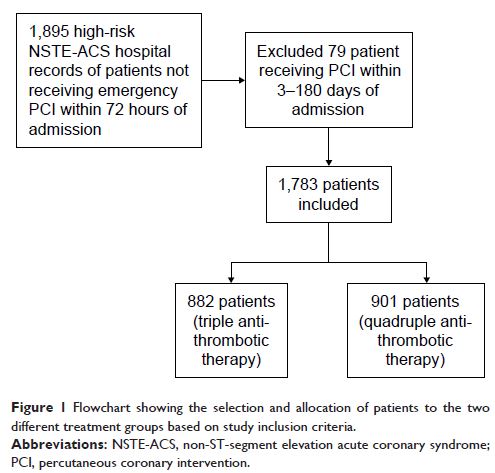108384
论文已发表
注册即可获取德孚的最新动态
IF 收录期刊
- 3.4 Breast Cancer (Dove Med Press)
- 3.2 Clin Epidemiol
- 2.6 Cancer Manag Res
- 2.9 Infect Drug Resist
- 3.7 Clin Interv Aging
- 5.1 Drug Des Dev Ther
- 3.1 Int J Chronic Obstr
- 6.6 Int J Nanomed
- 2.6 Int J Women's Health
- 2.9 Neuropsych Dis Treat
- 2.8 OncoTargets Ther
- 2.0 Patient Prefer Adher
- 2.2 Ther Clin Risk Manag
- 2.5 J Pain Res
- 3.0 Diabet Metab Synd Ob
- 3.2 Psychol Res Behav Ma
- 3.4 Nat Sci Sleep
- 1.8 Pharmgenomics Pers Med
- 2.0 Risk Manag Healthc Policy
- 4.1 J Inflamm Res
- 2.0 Int J Gen Med
- 3.4 J Hepatocell Carcinoma
- 3.0 J Asthma Allergy
- 2.2 Clin Cosmet Investig Dermatol
- 2.4 J Multidiscip Healthc

已发表论文
包括替罗非班在内的四联疗法在治疗未能及时接受经皮冠状动脉介入的中国 NSTE-ACS 患者时的疗效和安全性
Authors Li L, Ge Z, Zhang D, Kuang J, Ma X, Jiang S
Received 4 April 2017
Accepted for publication 24 July 2017
Published 21 November 2017 Volume 2017:11 Pages 3299—3307
DOI https://doi.org/10.2147/DDDT.S138714
Checked for plagiarism Yes
Review by Single-blind
Peer reviewers approved by Dr Colin Mak
Peer reviewer comments 3
Editor who approved publication: Dr Qiongyu Guo
Background: Although it has
been shown to be superior to simple antithrombotic drug therapy, most patients
are unable to receive timely percutaneous coronary intervention (PCI) and are
treated with conventional triple antithrombotic therapy (aspirin, clopidogrel,
low-molecular-weight heparin). Here, we evaluate the efficacy and safety of
adding low-dose tirofiban to this regimen.
Methods: A total of 1,783 patient records (unable to receive PCI) indicating non-ST-segment elevation acute coronary syndrome (NSTE-ACS) were included. A total of 882 received conventional triple antithrombotic therapy; 901 received quadruple antithrombotic therapy. Efficacy was evaluated in terms of major adverse cardiovascular event (MACE) parameters. Safety was evaluated based on the occurrence of bleeding events. Data were collected over a 6-month period post treatment.
Results: The rate of occurrence of MACE was significantly lower in the quadruple antithrombotic group (10.5% versus 14.1% at 6 months, P =0.02). The log-rank test showed improved survival in the quadruple antithrombotic group. Total bleeding events were higher in the quadruple antithrombotic group (9.7%) than in the triple antithrombotic group (7.1%) (P =0.04); however, this may be attributed to increased clinically insignificant minor bleeding events.
Conclusion: Quadruple antithrombotic therapy demonstrated a superior alternative for the treatment of high-risk NSTE-ACS patients failing to receive PCI.
Keywords: low-dose tirofiban, non-ST-segment elevation acute coronary syndrome, quadruple drug therapy
Methods: A total of 1,783 patient records (unable to receive PCI) indicating non-ST-segment elevation acute coronary syndrome (NSTE-ACS) were included. A total of 882 received conventional triple antithrombotic therapy; 901 received quadruple antithrombotic therapy. Efficacy was evaluated in terms of major adverse cardiovascular event (MACE) parameters. Safety was evaluated based on the occurrence of bleeding events. Data were collected over a 6-month period post treatment.
Results: The rate of occurrence of MACE was significantly lower in the quadruple antithrombotic group (10.5% versus 14.1% at 6 months, P =0.02). The log-rank test showed improved survival in the quadruple antithrombotic group. Total bleeding events were higher in the quadruple antithrombotic group (9.7%) than in the triple antithrombotic group (7.1%) (P =0.04); however, this may be attributed to increased clinically insignificant minor bleeding events.
Conclusion: Quadruple antithrombotic therapy demonstrated a superior alternative for the treatment of high-risk NSTE-ACS patients failing to receive PCI.
Keywords: low-dose tirofiban, non-ST-segment elevation acute coronary syndrome, quadruple drug therapy
